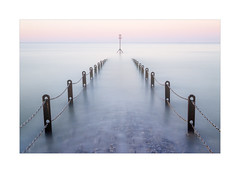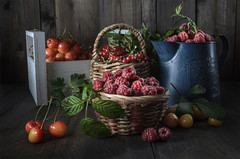 I’d been working on this little quilt for quite some time. It all started when I worked at a quilt shop and was admiring all the cute 1930’s reproduction prints that would come and go from stock. I began collecting them whenever there was a stray fat quarter or less leftover. If there was a sale, I’d get an 1/8 of a yard of several of them. There were so many to choose from and I’d hoped I could get enough so that there would be no repeat uses of any one design in the quilt. It didn’t work out that well, but I did manage to collect enough to create a quilt that was quite ‘patchy’ and one that I’m very pleased with. This was a project that I kept in a small box and would take out every so often to work on. One time, when I was cutting a stack of the fabrics into squares with a rotary cutter, I actually sliced into my pinky finger! I spent a few hours at the emergency room to get stitches but they were so busy that I called it quits and picked up some butterfly strips at the pharmacy to mend the finger myself. To no avail, I ended up losing the chunk off of my fingertip anyway but now you can barely notice it at all. After that little trauma, I had put this project away and probably for psychological reasons, let it be unfinished for another 8 years. When I got an embroidery machine and discovered the redwork designs I could do, is when I got the idea to incorporate them into the retro patchwork quilt. That was all the motivation I needed and I set to work on finishing it up. I did get the top finished rather fast but ran into a design decision with the border – whether to scallop it or leave the edges straight. My friend Jan had a good point when she told me that she thought the scallops would detract from an already busy quilt. Then that was all I needed for another push. It is easier to do a straight border than a scalloped that’s for sure. The urge to finish one of my many UFO’s was so strong that I got right on it and finished quilting it and binding it within the next day.
I’d been working on this little quilt for quite some time. It all started when I worked at a quilt shop and was admiring all the cute 1930’s reproduction prints that would come and go from stock. I began collecting them whenever there was a stray fat quarter or less leftover. If there was a sale, I’d get an 1/8 of a yard of several of them. There were so many to choose from and I’d hoped I could get enough so that there would be no repeat uses of any one design in the quilt. It didn’t work out that well, but I did manage to collect enough to create a quilt that was quite ‘patchy’ and one that I’m very pleased with. This was a project that I kept in a small box and would take out every so often to work on. One time, when I was cutting a stack of the fabrics into squares with a rotary cutter, I actually sliced into my pinky finger! I spent a few hours at the emergency room to get stitches but they were so busy that I called it quits and picked up some butterfly strips at the pharmacy to mend the finger myself. To no avail, I ended up losing the chunk off of my fingertip anyway but now you can barely notice it at all. After that little trauma, I had put this project away and probably for psychological reasons, let it be unfinished for another 8 years. When I got an embroidery machine and discovered the redwork designs I could do, is when I got the idea to incorporate them into the retro patchwork quilt. That was all the motivation I needed and I set to work on finishing it up. I did get the top finished rather fast but ran into a design decision with the border – whether to scallop it or leave the edges straight. My friend Jan had a good point when she told me that she thought the scallops would detract from an already busy quilt. Then that was all I needed for another push. It is easier to do a straight border than a scalloped that’s for sure. The urge to finish one of my many UFO’s was so strong that I got right on it and finished quilting it and binding it within the next day.
I’ve decided to keep this quilt for my house. I have no young children, but I hope to have grandchildren that may come to stay and visit once in a while. I hope to pass on my appreciation of the historical implications this quilt has for me. No, I don’t mean the memories of rotary cutting accidents and procrastinating on projects! When I was a little kid, I used to see my aunt working on a dresden plate quilt at my grandmother’s house. She used cardboard templates which I helped with by tracing around the edges, onto the back of the fabric pieces. I’m not sure if those fabrics were from leftover feedsack fabrics that my Mom told me about, or if she had bought them more recently. I love the story that Mom tells of when she was a little girl that Grandma would make all the dresses out of flour sacks. I’d always imagined that she meant all her dresses were made of a solid muslin type of fabric, but then I figured it all out when I learned about the printed feedsack reproduction fabrics at the quilt shop that I worked at later on. Those must have been some really cute dresses, even if they were typically worn by children from less affluent families. I remember my Mom embroidering things every now and then, admiring how beautiful and inexpensive it was to do. That, along with exposure to the illustrations in my formative ‘learning to read’ years from books like “Dick and Jane” – I developed an appreciation for the Redwork style of embroidery. In addition to this nostalgia, add the memories of my Nana, who also was a very creative and practical woman who exposed me to her stitching adventures seemingly every time I’d visited her. I used to watch everything she did, and even would go under the table to confiscate her fabric scraps from the floor as she sewed, trying to imagine what I could use them for. She had a toybox full of old fashioned toys for the grandchildren to play with and she would think of fun and interesting things to do with us. It is because of fond memories such as these that I commemorate this quilt to the hard working, industrious women of my heritage, and reserve it for my own grandchildren someday to enjoy at this “Nana’s” house.









